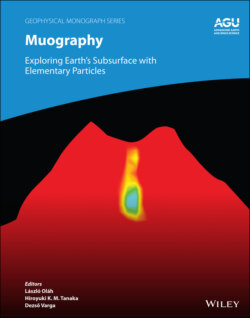Читать книгу Muography - Группа авторов - Страница 61
4.1.2 Volcano Eruption Forecasting With Machine Learning
ОглавлениеVolcano eruption prediction (Sparks, 2003) has three main categories: (i) long‐term eruption prediction aims to forecast future catastrophic events based on the compilation of various scientific and historic data. Although occurrence of catastrophic eruptions is very rare and thus modeling of volcanic mechanism is not possible, this is a highly studied area that is under continuous development. (ii) Mid‐term eruption prediction aims to forecast eruptions that can influence daily human activities. These kinds of eruptions occur more frequently, thus the eruption mechanism can be explored and a model of eruption mechanism can be developed. (iii) Short‐term eruption prediction is based on observation of volcanic phenomena occurring anywhere from a few minutes to a few days before the eruptions. Short‐term eruptions occur frequently and they can have strong impacts on the surrounding areas, e.g. the 2014 eruption of Mount Ontake, Honsu, Japan, caused enormous damage to tourists and local population (Yamaoka et al., 2016).
Automatic classification of seismic signals originating from active volcanoes (Falsaperla et al., 1996; Langer et al., 2013; Ren et al., 2020; Scarpetta et al., 2005) and video data of plume rise (Witsil & Johnson, 2020) helped to characterize and elucidate eruptions’ behavior. ML‐based analysis of time series of gas emission, gravimetric, and tilting data alerted us one day before the occurrence of flank eruptions (Brancato et al., 2019). Deep learning‐based image analysis procedures allowed us to classify volcano deformations (Anantrasirichai et al., 2018; Gaddes et al., 2019) and understand how lava flows occurred (Corradino et al., 2019), and demonstrated its applicability for automatic prediction of future volcano behavior.
In recent years, muography has achieved progress in monitoring and exploring subsurface density distributions of various geological edifices, such as active volcanoes (Lesparre et al., 2012; Lo Presti et al., 2020; Oláh et al., 2019b; Tanaka et al., 2007, 2014) or underground rock structure (Cimmino et al., 2019; Gluyas et al., 2019; Guardincerri et al., 2017; Lázaro Roche et al. 2019, Lesparre et al., 2017; Oláh et al., 2012; Oláh et al., 2018a; Schouten & Lendru, 2018; Tanaka, 2015). The application of 3D image transformation techniques (Nagahara & Miyamoto, 2018; Tanaka et al., 2010) and the integration of muography with gravimetry (Barnoud et al., 2021; Davis & Oldenburg, 2012; Nishiyama et al., 2014; Okubo & Tanaka, 2012) allow us to resolve geological edifices with a voxel size of a few tens of meters. The combination of muography with seismic monitoring allows the detection of abrupt density changes in hydrothermal systems (Le Gonidec et al., 2019). ML‐based muographic image processing is under development to predict short‐term volcano eruptions (Nomura et al., 2020).
Currently, only the Sakurajima volcano shows persistent activity among the volcanoes that are continuously monitored with muography during recent years (D'Alessandro et al., 2019; Le Gonidec et al., 2019; Lo Presti et al., 2020; Oláh et al., 2019b). The Sakurajima volcano is an andesitic composite volcano formed on the Aira caldera in Kagoshima Bay, Kyushu, Japan. The last plinian eruption occurred in 1914. A recent study has shown that the magma supply rate of the Aira caldera amassed enough magma within approx. 130 years to feed a plinian type eruption (Hickey et al., 2016). The two craters, Minamidake and Showa, have erupted explosively more than 3,000 times in the last five years (Japan Meteorological Agency, 2020). The mechanism of these vulcanian type eruptions (Iguchi et al., 2008; Kazahaya et al., 2016) is reviewed in another chapter of this monograph (Oláh & Tanaka, 2021). During these eruptions, one of the two active craters ejected aerosols and gas with a bulk volume of below 107m to a height of 1,000–5,000 m above the crater rims, throwing fragments of volcanic plug and lava bombs usually within approx. 3,000 m radius. Although sometimes the injected ash cloud reached Kagoshima City and caused difficulties to the local transport, the activity of the Sakurajima volcano usually impacts the nearby area that is continuously visited by tourists. The constant threat to this area motivates the improvement and coordination of volcano monitoring techniques. The forecasting of short‐term eruptions of the Sakurajima volcano is a good candidate for using ML techniques to automate muographic image processing. The Multi‐Wire‐Proportional‐Chamber (MWPC)‐based Muography Observation System (MMOS) (Oláh et al., 2018b, 2019a; Varga et al., 2015, 2016, 2020) of Sakurajima Muography Observatory (SMO) has acquired sufficient amounts of data since 2018 to study the feasibility and limits of forecasting short‐term, vulcanian type eruptions.
In this chapter, we focus on how ML techniques can process muographic images captured through the Sakurajima volcano for the forecasting of impending vulcanian type eruptions. Our analysis is based on recently developed methods that are applied on new data sets collected by the MMOS during the eruption episodes of the Minamidake crater occurring between October 2018 and July 2020.
